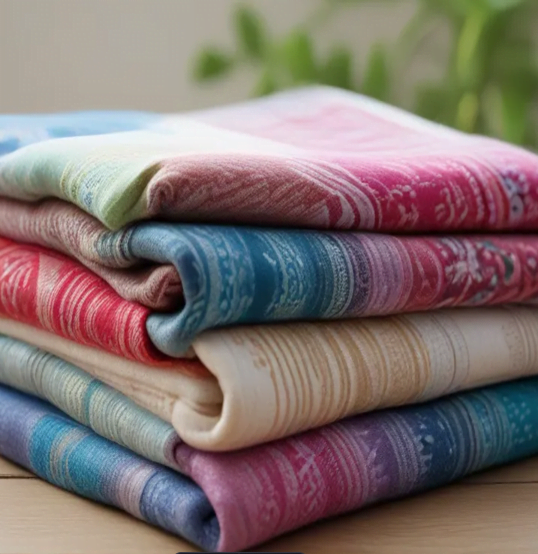
WHO Insights on Sustainable Fashion and Cashmere Clothing
Sustainable fashion is no longer just a trend in a society increasingly concerned with environmental effect and ethical standards; it is a requirement. Cashmere stands out among the different materials that have acquired popularity during this green revolution due to its sumptuous feel, cultural relevance, and eco-friendliness. This blog digs into the beauty of cashmere apparel and its significance in the sustainable fashion movement, drawing on statistics and insights from the World Health Organisation (WHO) and other trustworthy sources.
WHO Insights on the Environmental and Health Impacts of the Textile Industry

Environmental Impact of the Textile Industry
The World Health Organisation (WHO) has conducted significant research into the textile industry's environmental and health implications. Traditional textile production procedures, particularly those that use synthetic fibres, contribute significantly to environmental contamination. This involves the release of harmful chemicals, microplastics, and heavy metals into water bodies, as well as significant air pollution caused by industrial emissions.
Air quality and Respiratory Health
According to the World Health Organisation, air pollution from textile manufacturing poses a significant global health concern. Fine particulate matter (PM2.5) from these factories can enter deep into the lungs, causing a variety of respiratory issues such as asthma, chronic bronchitis, and cancer. By using natural fibres such as cashmere, which require less industrial processing, the fashion industry may reduce its contribution to air pollution, boosting global air quality and lung health.
Water Pollution and Chemical Exposure
According to the World Health Organisation, the textile sector is one of the world's leading pollutants of pure water. The dyes and chemicals used in traditional textile manufacture frequently end up in rivers and lakes, poisoning drinking water and posing serious health hazards to local communities. Waterborne diseases including cholera, dysentery, and other gastrointestinal infections are common in places with dirty water sources. Sustainable cashmere production with fewer toxic chemicals can considerably reduce these dangers and create cleaner water.
Occupational Health and Safety
Workers in the textile business are frequently exposed to dangerous chemicals and unsafe working conditions, which contribute to occupational diseases and injuries. The WHO supports for higher health and safety standards in textile manufacturing to safeguard workers from these hazards. Cashmere manufacture, which is heavily reliant on traditional handcrafting techniques, often involves safer working conditions than large-scale industrial textile production. This safeguards workers' health while also preserving their cultural legacy.
Economic and Social Benefits
The World Health Organisation emphasises the relevance of sustainable economic practices in enhancing public health. Cashmere manufacture helps craftspeople in rural Himalayan communities earn a living, which contributes to economic stability and social well-being. By purchasing cashmere products, consumers may help to alleviate poverty and improve access to healthcare and education.
Reduced chemical use and healthier ecosystems.
According to the WHO, one of the most important environmental benefits of cashmere is the reduction of toxic chemicals used in its production. This results in healthier ecosystems, which promotes improved public health outcomes. The minimum use of pesticides and fertilisers in Changthangi goat grazing regions contributes to soil health and biodiversity, which are critical for a balanced environment.
Cashmere Clothing: A Sustainable Alternative
Cashmere apparel is a sustainable alternative to traditional textiles that adheres to WHO criteria for decreasing environmental and health implications.
-

Minimal Chemical Use
Cashmere manufacture requires substantially less chemicals than synthetic fibres. The conventional techniques of producing cashmere minimise toxic chemicals, lowering the risk of water and soil contamination.
-

Biodegradability
Cashmere, as a natural fibre, is biodegradable, as opposed to synthetic fibres, which can last for centuries in the environment. This contributes to a reduction in long-term environmental contamination and the accompanying health hazards.
-

Low Energy Consumption
Cashmere production uses far less energy than industrial textile manufacturing due to the handcrafting techniques used. This helps to reduce greenhouse gas emissions, which aids in the fight against climate change and its health consequences, as noted by the WHO.
-

Healthier Work Environments
Cashmere artisans often operate under better settings, with less exposure to toxic chemicals. This is consistent with WHO's mission of improving occupational health and safety.
-

Economic Empowerment
Cashmere manufacture helps craftspeople in rural Himalayan areas earn a living. Consumers who buy cashmere clothes help to strengthen these communities by increasing access to healthcare and education. The World Health Organisation recognises economic stability as a critical component in enhancing public health outcomes.
-

Supporting WHO’s Sustainability Goals
Purchasing cashmere apparel contributes to various WHO sustainability goals, including encouraging healthier ecosystems by lowering chemical usage and sustaining traditional grazing techniques that enhance biodiversity and minimise vector-borne diseases. Furthermore, cashmere's low environmental impact helps lower health risks connected with air and water pollution, in line with WHO recommendations for healthier settings.

The World Health Organization's findings emphasise the vital need for sustainable practices in the textile industry to protect the environment and human health. Cashmere apparel, with its ethical sourcing, minimum chemical use, and traditional manufacturing methods, is an excellent illustration of how sustainable fashion may meet WHO standards. By purchasing pashmina, consumers may help to create a healthier planet and population, furthering the WHO's aim of promoting health through sustainable development.







